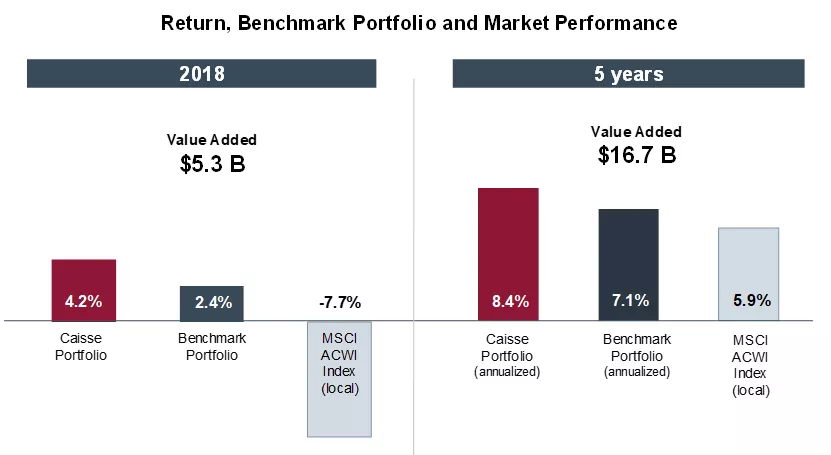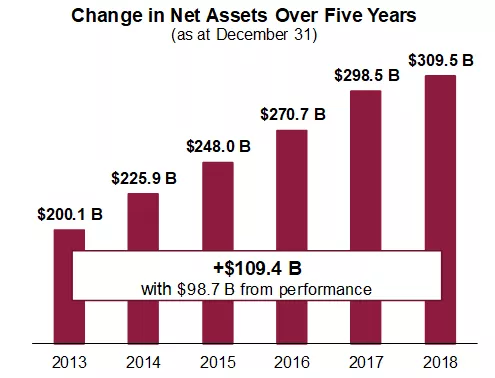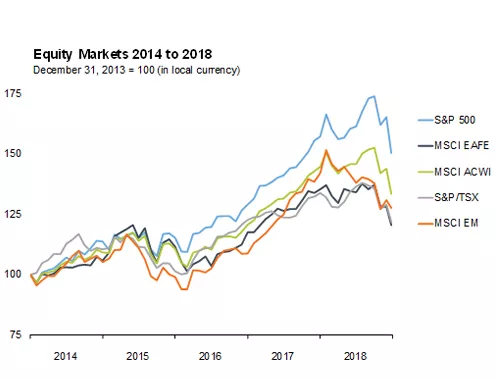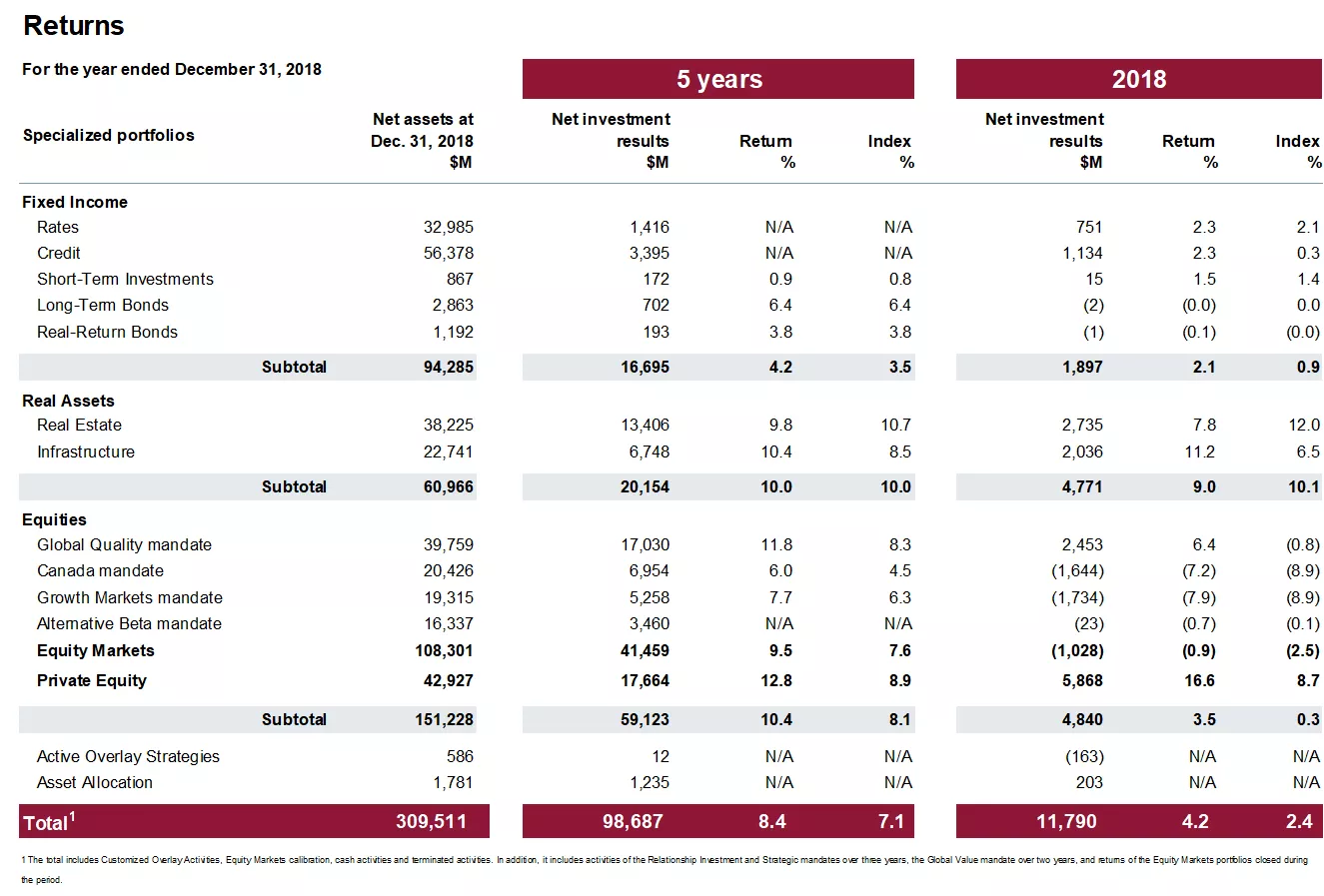La Caisse’s annualized return: 4.2% in 2018 and 8.4% over five years
Caisse de dépôt et placement du Québec (la Caisse) today released its financial results for the year ended December 31, 2018. The annualized weighted average return on its clients’ funds was 4.2% in 2018 and 8.4% over five years.
La Caisse’s performance compared against its benchmark portfolio represents $5.3 billion of value added for depositors in 2018. Over five years, a total of $16.7 billion of value was added.

“In 2018, our investment strategy was put to the test. For the first time in several years, global stock markets finished the year in negative territory due to the beginning of monetary policy normalization, rising tariffs and geopolitical uncertainty. We achieved our objective of building a robust and resilient portfolio that performs well in these kinds of markets. The significant value added that was created this year and over five years shows that what we put into place has been effective, benefiting all Quebecers,” said Michael Sabia, President and Chief Executive Officer of la Caisse.
falsefalsePleine largeurfalse
Net assets rose to $309.5 billion, up more than 50% from five years ago. This represents an increase of $109.4 billion since 2013, with net investment results of $98.7 billion and $10.7 billion in net client deposits. In 2018, net investment results were $11.8 billion and net withdrawals were $0.8 billion, mainly due to net withdrawals of $3 billion by the Government of Québec’s Generations Fund.

“Our investment in Québec’s private sector continued to expand, reaching $44.3 billion in 2018. During the year, we helped Québec companies grow and expand internationally. Our investment approach also focused on the new economy, with nearly 40% of our transactions conducted in those sectors,” added Michael Sabia.
“We need to be prepared for volatile markets reacting to uncertainty arising from a slowing global economy, which we’re already seeing in China and, increasingly, in the United States, as well as the impact of geopolitical risks on consumer confidence, business investment and consequently, on the real economy. In this environment, we will continue to execute our strategy to deliver solid long-term results,” concluded the President and Chief Executive Officer of la Caisse.
falsefalsePleine largeurfalse
HIGHLIGHTS
In 2018, la Caisse pursued its investment strategy, which focuses on globalization, absolute-return management, less-liquid assets, credit activities and impact in Québec. In a year filled with uncertainty for investors, la Caisse’s performance delivered returns to its depositors that are higher than its benchmark. La Caisse’s clients benefited from the results produced by Private Equity and Infrastructure, which performed particularly well against their benchmarks for both one year and over five years. The performance of the Equities portfolio’s Global Quality mandate, which mainly contains securities of companies with solid and stable fundamentals, and the Credit portfolio, are also worth highlighting. While the Real Estate portfolio’s result was below its benchmark, it still generated a return of 7.8% for the year and 9.8% over five years.

Detailed information on the returns of each asset class is provided in the attached table and the backgrounders included with this news release.
Equities: Good performance in turbulent markets
In highly volatile global markets, the Equities asset class, which represents nearly half of la Caisse’s portfolio and includes securities of companies acquired in stock markets or as private equity, generated a 3.5% return in 2018, compared to its benchmark of 0.3%.
Equity Markets
In 2018, the performance of the Equity Markets portfolio reflected the strategy implemented in recent years. Over five years, its return of 9.5% outpaced its benchmark, which was 7.6%. With a return of -0.9% this year, the portfolio demonstrated its resilience compared to its benchmark’s return of -2.5%.
This performance is primarily attributable to the superior results of the Global Quality mandate, which is a pillar of la Caisse’s absolute-return management strategy. This mandate includes securities of quality companies exposed to global growth and traded on major stock exchanges. In 2018, it posted a return of 6.4% compared to -0.8% for its benchmark, a spread of 721 basis points, which is largely due to the selection of quality companies and the portfolio’s positioning in profitable sectors. This strategy allowed the portfolio to fully play its role as a source of resilience.

Private Equity
In 2018, the Private Equity portfolio totalled $42.9 billion, more than double its total from five years ago. Internationally, over $9 billion was deployed last year. The investment strategy continued to focus on quality partnerships and sustainable value creation. Many transactions were concluded with world-class partners around the world, including in the U.S. and Europe. Among them were investments in Germany-based Techem, valued at €4.6 billion, and in FNZ, a global fintech firm, which represented one of the world’s largest transactions in this sector in 2018 and was concluded as part of a long-term partnership created with Generation Investment Management. La Caisse’s investment in French engineering firm, Groupe Delachaux, which provides high-value-added industrial solutions, particularly in sustainable mobility and industrial efficiency, was also a highlight of the year.
In Canada, la Caisse announced a transaction with Avison Young, the world’s fastest-growing private commercial real estate services company. Lastly, the acquisition of a strategic minority stake in SURA Asset Management was announced at the end of the year. With this transaction, which will be confirmed once regulatory approval is obtained, the company will expand its financial services offering in several Latin American countries.
Real Assets: Strong partnerships and sectors of the future
In an environment where competition remains fierce for real assets, such as infrastructure and real estate, la Caisse puts several of its comparative advantages to use. It relies on the expertise of its teams, including its operational experts, as well as creating long-term partnerships to make direct investments that deliver good performance over time.
In 2018, several transactions were concluded in sectors related to key trends, including sustainable industry, technology, logistics and renewable energy.
Infrastructure
The Infrastructure portfolio had a pivotal year, with assets totalling $22.7 billion, up nearly $15 billion from 2013. Among the main transactions, la Caisse expanded its stake in Invenergy, a leading private North American renewable energy company, and Azure Power Global, an Indian leader in solar energy production. La Caisse also acquired a 40% interest in CLP India, with the goal of turning it into a leading renewable energy producer.
In Colombia, la Caisse announced the creation, with institutional partners, of a US$1-billion investment platform to make equity investments in infrastructure projects and companies. This platform is similar to the one created three years ago in Mexico, which exceeded its investment target of $2.8 billion upon closing the acquisition of eight solar and wind assets from Enel Green Power. In addition, an investment in Québec renewable energy producer, Boralex, which develops, builds and operates production sites in Canada, France, the U.K. and the U.S., helped increase the share of renewable assets in the Infrastructure portfolio to 20%.
Real Estate
In 2018, Ivanhoé Cambridge, la Caisse’s real estate subsidiary, actively pursued the repositioning of its portfolio with transactions (sales and acquisitions) totalling $16.6 billion. In particular, it increased its investments in the industrial and logistics sector, which is capitalizing on the global growth in ecommerce and complements the shopping centres in the portfolio.
In this sector, Ivanhoé Cambridge also made several major acquisitions that contributed to changing the sectoral allocation and selection of its assets. The acquisition of Pure Industrial Real Estate Trust made alongside Blackstone included 173 assets located in densely populated North American cities. More recently, Ivanhoé Cambridge acquired IDI Logistics and created a partnership with Oxford to invest in the company and its assets. This major transaction allows Ivanhoé Cambridge to expand its presence in logistics real estate in North America, with the acquisition of one of the largest developers and managers in this sector in the U.S. Lastly, at the beginning of 2019, Ivanhoé Cambridge confirmed a partnership of US$890 million in Brazil with Prologis, a world leader in logistics real estate.
Fixed Income: A profitable focus on credit
Despite the high level of uncertainty that triggered significant variations in bond markets in 2018, the Fixed Income asset class generated net investment results of $1.9 billion. This performance is mainly attributable to the shift that began in 2017 with the Credit portfolio. These activities, which include corporate credit, sovereign credit, real estate debt and specialty finance, positively impacted the portfolio, delivering a return that outpaced its benchmark by two hundred basis points. In addition, in specialty finance, la Caisse concluded several beneficial transactions on various continents, including loans to Boralex in Québec, to Tillman in the U.S. (telecommunication towers) and to ContourGlobal in Spain (portfolio of solar power assets).
Innovation and technology: Key elements of la Caisse’s approach in Québec
La Caisse continued to have a significant impact on the private sector in Québec: at the end of 2018, its assets in Québec totalled $63.8 billion, including $44.3 billion in the private sector. La Caisse was active with regard to new investments and commitments, which totalled $7.3 billion in 2018. These investments align with the pillars of la Caisse’s strategy—growth-creating projects, growth and globalization, and innovation and the next generation—while placing special focus on developing Québec’s new economy.
Growth-creating projects
Construction of the Réseau express métropolitain (REM), a $6.3-billion project led by Caisse subsidiary CDPQ Infra, advanced concretely in 2018. First, the preferred consortia were selected and the financing was concluded, setting the groundwork for the official project launch and beginning of construction less than two years after being announced. Over the last several months, construction work began on all the network branches, notably at the Technoparc Montréal, in the West Island, on the Deux-Montagnes line, on the South Shore and on the Édouard-Montpetit station.
In addition, Ivanhoé Cambridge continued to invest in Québec with projects such as Projet Nouveau Centre, a $1-billion plan to revitalize downtown Montréal. This project involves ongoing renovations at Place Ville Marie and the Eaton Centre, with $200 million investments in each to transform the user experience. The Projet Nouveau Centre also includes the reopening of the Fairmont The Queen Elizabeth and the delivery of the Maison Manuvie, which took place in 2017. In addition, a $60-million renovation was begun at Laurier Québec and a second investment vehicle of $100 million was created with Claridge for residential real estate projects in Québec’s urban centres.
Growth and globalization
As part of its strategy in Québec, la Caisse continues to support Québec companies as they grow and expand globally. In addition to financing, this support includes introducing companies to la Caisse’s teams and partners around the world. In 2018, la Caisse was involved with the growth and globalization of many companies, including Plusgrade, a technology company in the travel industry, Ocean Group, a leader in maritime services and AddÉnergie, a North American leader in electric vehicle charging solutions.
Innovation and the next generation
Over the last year, la Caisse has increased its investments to foster the growth of new economy companies. For example, it invested in Hopper, the world’s fastest-growing travel application. Other investments of note include Breather, which uses technology to provide work spaces, FX Innovation, specialized in IT consulting services and solutions, and Poka, a training and knowledge management platform that fosters the digital shift in the manufacturing sector. La Caisse also invested in La Maison Simons, a major retailer, to accelerate its digital offering.
In 2018, la Caisse, in collaboration with Mila – Quebec Artificial Intelligence Institute, created Espace CDPQ | Axe IA to house nine startups from innovative sectors. They will also have access to Mila’s academic resources as well as access to support, coaching and a network of experts from la Caisse and Espace CDPQ, to accelerate the commercialization of their technology.
Solid investments advancing the transition to a low carbon economy
In fall 2017, la Caisse announced its strategy to address climate change, which includes targets for reducing its carbon footprint by 25% per dollar invested by 2025 and increasing its low carbon investments by $8 billion by 2020. In 2018, la Caisse concluded several major transactions, both in Québec and around the world, in the renewable energy sector and in sustainable industries, including Invenergy, Techem, FNZ, Boralex and ContourGlobal. All these transactions played a part in positively advancing la Caisse’s portfolio toward the targets set under this strategy.
Details on la Caisse’s progress with its climate change strategy will be presented in its Stewardship Investing Report, which will be released in March.
FINANCIAL REPORTING
La Caisse’s operating expenses, including external management fees, totalled $680 million in 2018. The expense ratio was 22 cents per $100 of average net assets, a level that is unchanged from last year and that compares favourably to that of its industry.
The credit rating agencies reaffirmed la Caisse’s investment-grade ratings with a stable outlook, namely AAA (DBRS), AAA (S&P), Aaa (Moody’s) and AAA (Fitch Ratings).
RETURNS

ABOUT CAISSE DE DÉPÔT ET PLACEMENT DU QUÉBEC
Caisse de dépôt et placement du Québec (CDPQ) is a long-term institutional investor that manages funds primarily for public and parapublic pension and insurance plans. As at December 31, 2018, it held CA$309.5 billion in net assets. As one of Canada’s leading institutional fund managers, CDPQ invests globally in major financial markets, private equity, infrastructure, real estate and private debt. For more information, visit cdpq.com, follow us on Twitter @LaCDPQ or consult our Facebook or LinkedIn pages.
- 30 -


